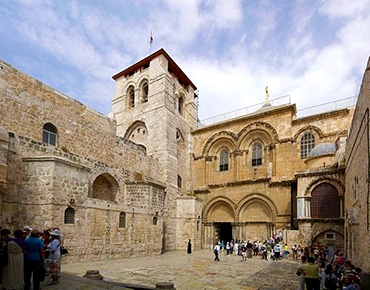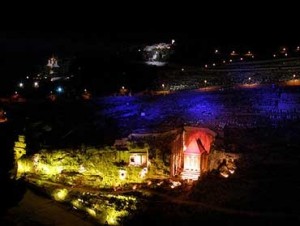The Church of the Holy Sepulchre
Church of the Holy Sepulchre
Believed by most to be built on the site of the Christian Savior‘s crucifixion and burial, the Church of the Holy Sepulchre has a long history. The church was twice leveled to the ground, suffered earthquake damage, and in 1834 was the site of several deaths when parishioners were crushed in a rush to escape a fire that broke out during the Greek Orthodox Holy Fire ceremony.
Visiting the Sepulchre Church
Today, the church continues to attract thousands of Pilgrims to Jerusalem, with estimates citing 5,000 visitors to the site on any given day. Pilgrims are surrounded with history from the moment they step foot inside the Christian Quarter in Jerusalem’s Old City. Let’s take a look.
The first thing you’ll notice is the Crusader-built façade on the eastern side of the church, a double-arched passageway spanning two levels and held in place by cornices. The door to the right of the entrance was closed off when the Mamluks took control of the site after they defeated the Crusaders in 1187.
Inside the Church of the Sepulchre
A high bench is just inside the doorway to the left, where an Arab doorkeeper sat for centuries. Muslims held the keys to the church, the basis for which is shrouded in Muslim tradition. The exact timing of when the keys came into Muslim control ranges from 638 to 809 CE. While the keys are still held by two Muslim families, the daily management of the church is spread between different Christian denominations.
Today, custodial church duties are shared between the Greek Orthodox, Armenian Apostolate, and Roman Catholic Church. During the 19th century, the Ethiopian, Syriac, and Coptic Churches assumed some minor responsibilities, including the care of shrines inside and outside the church building. The various denominations keep to a strict schedule of worship, in which each faction uses common areas at specific times.
From the courtyard, to your left when facing the entrance, you can see the 11th century chapels built by the Greek Orthodox atop the site where Constantine’s baptistery once stood. The wall to the east contains a domed edifice that was formerly the 12th century Crusader entryway to Church. Later, the site was reconsecrated as the Chapel of the Franks.

Guillaume Paumier CC BY 3.0
The Stone of Unction
Just inside the Church of the Holy Sepulchre is a slab of limestone known as the Stone of Unction. This is the site reputed the body of the Christian Savior is reputed to have been washed for burial. The original stone placed there in the 12th century by the Crusaders was replaced by the current slab dating to 1808. The area is lit with lavishly decorated lamps supplied by Greeks, Armenians, Roman Catholics and the Coptic Orthodox. A mosaic depicting the anointing of the body for burial is just behind the stone on the exterior wall of the Catholicon.
Via Dolorosa Stations
A stairway to the right takes visitors to the Place of Crucifixion. Here you’ll see the Franciscan Chapel of the Nailing of the Cross, Station 11 on the Via Dolorosa, with its 12th century mosaic of the crucifixion and Florentine Medici altar. To the south wall is the Chapel of the Agony of the Virgin with a statue of Mary to the left. This is Our Lady of Sorrows, or Station 13, representing the removal of the body from the cross and its presentation to Mary.
Crucifixion Site

Максим Массалитин CC BY 2.0
The Calvary (Orthodox Crucifixion Site)
The interior of the church is home to a rocky protrusion said to be the site of the crucifixion. Archaeological evidence proves the site once lay just outside the city walls, where the Christian Gospel states the crucifixion took place. The Place of Crucifixion chapel is overseen by the Greek Orthodox Church.
A shrine known as the edicule memorializes the presumed location of the tomb of the Christian Savior. The tomb that once stood here was hacked down to the bedrock at the direction of Muslim Caliph al-Hakim in 1009 CE.
Originally, the Roman Emperor Hadrian had an earthen foundation laid over the area and a statue of Jupiter erected on this spot, where it stood for almost two centuries until Constantine converted the Romans, destroyed the pagan temples and built a church on the spot, consecrated in 333 CE.
The Rotunda or Anastasis area is a topped by a 20.5 meter dome that is 34 meters high. The Rotunda preserves the place of the original 333 CE church and was completed in the 1960’s. Its 12-pointed star decoration, added in 1997, symbolizes the 12 apostles .
The Church of the Holy Sepulchre: Did You Know?
Past the pillars of the Rotunda, the western entryway to the Syrian chapel contains a narrow corridor leading to the Tomb of Joseph of Arimathea, a 1st century tomb. Tradition has it he ceded his own tomb to the Christian Savior and was placed here instead. This is where Syriac Orthodox Christians say mass every Sunday.








